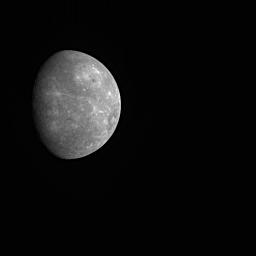This is the last image MDIS took of Mercury during MESSENGER’s first flyby of the planet before the spacecraft turned its antennas to begin transmitting the flyby data to Earth. Even at this great distance, the giant Caloris basin can be identified as a brighter circular region in the upper right of the planet. Two weeks from today, on October 6, 2008, MESSENGER will fly by Mercury again. The geometry of the second Mercury flyby is different from the first encounter, in that the point of closest approach will be nearly on the opposite side of the planet. As a result, MESSENGER will view about 30% of Mercury’s surface previously never before seen by spacecraft. This new territory is located just to the left of the day/night terminator in this image.
During the second encounter, 1287 MDIS images are planned. MESSENGER’s Magnetometer will also be making the first magnetic field measurements over the western hemisphere of the planet. The observations of Mercury’s tenuous atmosphere and neutral sodium tail will be more extensive than during the first flyby, and the angular resolution of the plasma spectrometer has been improved since the first flyby as a result of new software. The laser altimetry profile during the second flyby will be over areas that have been imaged by Mariner 10 or MESSENGER, which will permit the correlation of topographic characteristics and imaged features such as craters and faults to a degree never before possible.
Date Acquired: January 15, 2008
Image Mission Elapsed Time (MET): 108899804
Instrument: Narrow Angle Camera (NAC) of the Mercury Dual Imaging System (MDIS)
Resolution: 22 kilometers/pixel (14 miles/pixel)
Scale: Mercury’s diameter is 4880 kilometers (3030 miles)
Spacecraft Altitude: 440,000 kilometers (270,000 miles)
These images are from MESSENGER, a NASA Discovery mission to conduct the first orbital study of the innermost planet, Mercury. For information regarding the use of images, see the MESSENGER image use policy.

 Planetary Data System
Planetary Data System












